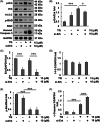Erk phosphorylation reduces the thymoquinone toxicity in human hepatocarcinoma
- PMID: 34173702
- PMCID: PMC8456969
- DOI: 10.1002/tox.23317
Erk phosphorylation reduces the thymoquinone toxicity in human hepatocarcinoma
Abstract
Although enormous achievements have been made in targeted molecular therapies against hepatocellular carcinoma (HCC), the treatments can only prolong the life of patients with extrahepatic metastases. We evaluated thymoquinone (TQ), a compound from Nigella sativa Linn., for its anti-cancer effect on SK-Hep1 cells and HCC-xenograft nude mice. TQ effectively triggered cell death and activated p38 and extracellular signal-regulated kinases (Erk) pathways up to 24 h after treatment in cells. TQ-induced cell death was reversed by p38 inhibitor; however, it was enhanced by si-Erk. The caspase3 activation and TUNEL assay revealed a stronger toxic effect upon co-treatment with TQ and si-Erk. Our study suggested that phosphorylation of p38 in SK-Hep1 cells constituted the major factor leading to cell apoptosis, whereas phosphorylation of Erk led to drug resistance. Furthermore, TQ therapeutic effect was improved upon Erk inhibition in HCC-xenograft nude mice. TQ could present excellent anti-HCC potential under suitable p-Erk inhibiting conditions.
Keywords: Erk; SK-Hep1 cells; hepatocellular carcinoma; p38; thymoquinone.
© 2021 The Authors. Environmental Toxicology published by Wiley Periodicals LLC.
Conflict of interest statement
The authors declare that they have no competing interests.
Figures







Similar articles
-
Thymoquinone inhibits tumor growth and induces apoptosis in a breast cancer xenograft mouse model: the role of p38 MAPK and ROS.PLoS One. 2013 Oct 2;8(10):e75356. doi: 10.1371/journal.pone.0075356. eCollection 2013. PLoS One. 2013. PMID: 24098377 Free PMC article.
-
Glycyrrhizic Acid Modulates Apoptosis through Extrinsic/Intrinsic Pathways and Inhibits Protein Kinase B- and Extracellular Signal-Regulated Kinase-Mediated Metastatic Potential in Hepatocellular Carcinoma In Vitro and In Vivo.Am J Chin Med. 2020;48(1):223-244. doi: 10.1142/S0192415X20500123. Am J Chin Med. 2020. PMID: 32054305
-
TQ inhibits hepatocellular carcinoma growth in vitro and in vivo via repression of Notch signaling.Oncotarget. 2015 Oct 20;6(32):32610-21. doi: 10.18632/oncotarget.5362. Oncotarget. 2015. PMID: 26416455 Free PMC article.
-
Mitochondrial Dysfunction and Induction of Apoptosis in Hepatocellular Carcinoma and Cholangiocarcinoma Cell Lines by Thymoquinone.Int J Mol Sci. 2022 Nov 24;23(23):14669. doi: 10.3390/ijms232314669. Int J Mol Sci. 2022. PMID: 36498999 Free PMC article.
-
Dissecting the roles of thymoquinone on the prevention and the treatment of hepatocellular carcinoma: an overview on the current state of knowledge.Infect Agent Cancer. 2019 Apr 16;14:10. doi: 10.1186/s13027-019-0226-9. eCollection 2019. Infect Agent Cancer. 2019. PMID: 31015860 Free PMC article. Review.
Cited by
-
Molecular mechanisms and signaling pathways of black cumin (Nigella sativa) and its active constituent, thymoquinone: a review.Mol Biol Rep. 2023 Jun;50(6):5439-5454. doi: 10.1007/s11033-023-08363-y. Epub 2023 May 8. Mol Biol Rep. 2023. PMID: 37155017 Review.
-
The Cytotoxic Effect of Thymoquinone Enhance on HepG2 Cell Line due to Induction of Fenton Reaction by Hydrogen Peroxide: An In Vitro and In Silico Study.Asian Pac J Cancer Prev. 2023 May 1;24(5):1809-1815. doi: 10.31557/APJCP.2023.24.5.1809. Asian Pac J Cancer Prev. 2023. PMID: 37247304 Free PMC article.
-
Biological Potential of the Main Component, Thymoquinone, of Nigella sativa in Pulp Therapy-In Vitro Study.Life (Basel). 2022 Sep 15;12(9):1434. doi: 10.3390/life12091434. Life (Basel). 2022. PMID: 36143470 Free PMC article.
-
The Role of Thymoquinone in Inflammatory Response in Chronic Diseases.Int J Mol Sci. 2022 Sep 6;23(18):10246. doi: 10.3390/ijms231810246. Int J Mol Sci. 2022. PMID: 36142148 Free PMC article. Review.
-
Thymoquinone induces apoptosis in temozolomide-resistant glioblastoma cells via the p38 mitogen-activated protein kinase signaling pathway.Environ Toxicol. 2023 Jan;38(1):90-100. doi: 10.1002/tox.23664. Epub 2022 Sep 29. Environ Toxicol. 2023. PMID: 36176197 Free PMC article.
References
-
- Torre LA, Bray F, Siegel RL, Ferlay J, Lortet‐Tieulent J, Jemal A. Global Cancer statistics, 2012. CA Cancer J Clin. 2015;65:87‐108. - PubMed
-
- Wang WY, Qin HL, Zhou L, Ma JL. Meta‐analysis of the relationship between microRNA‐499 rs3746444 polymorphism and hepatocellular carcinoma risk in Asians. J Cancer Res Ther. 2016;12:676‐680. - PubMed
-
- Hsu SC, Kuo CL, Lin JP, et al. Crude extracts of Euchresta formosana radix inhibit invasion and migration of human hepatocellular carcinoma cells. Anticancer Res. 2007;27:2377‐2384. - PubMed
MeSH terms
Substances
Grants and funding
LinkOut - more resources
Full Text Sources
Medical
Miscellaneous

